Toster - Understanding the Rails Web Model and Scalability Options
- 1. “ Genius is the gold in the mine; talent is the miner who works and brings it out. ” Lady Marguerite Blessington Donets Basin Coal Mine-Ukraine
- 2. “ Genius is the gold in the mine; talent is the miner who works and brings it out. ” Lady Marguerite Blessington Презентация начнется в течение нескольких минут ... Donets Basin Coal Mine-Ukraine
- 3. доброе утро
- 4. Fabio Akita, Co-Founder @CodeMiner42
- 5. “Off-centered software for off-centered people” Fabio Akita, Co-Founder @CodeMiner42
- 8. Understanding the Rails Web Model and Scalability Options
- 9. ?
- 12. rails new app
- 16. CGI
- 17. 1 request blocks 1 process
- 18. require 'rubygems' require 'rack' class Test def call(env) sleep 1 # on purpose, simulating a blocking operation [200, {"Content-Type" => "text/plain"}, ["Hello World!"]] end end Rack::Handler::Thin.run Test.new
- 19. require 'rubygems' require 'rack' class Test def call(env) sleep 1 # on purpose, simulating a blocking operation [200, {"Content-Type" => "text/plain"}, ["Hello World!"]] end end Rack::Handler::Thin.run Test.new
- 20. $ rackup config.ru >> Thin web server (v1.3.1 codename Triple Espresso) >> Maximum connections set to 1024 >> Listening on 0.0.0.0:8080, CTRL+C to stop
- 21. ab -n 10 -c 1 http://127.0.0.1:8080/ This is ApacheBench, Version 2.3 <$Revision: 1178079 $> ... Concurrency Level: 1 Time taken for tests: 10.020 seconds ... Requests per second: 1.00 [#/sec] (mean) Time per request: 1002.015 [ms] (mean) Time per request: 1002.015 [ms] (mean, across all concurrent requests) Transfer rate: 0.12 [Kbytes/sec] received ...
- 22. ab -n 10 -c 1 http://127.0.0.1:8080/ This is ApacheBench, Version 2.3 <$Revision: 1178079 $> ... Concurrency Level: 1 Time taken for tests: 10.020 seconds ... Requests per second: 1.00 [#/sec] (mean) Time per request: 1002.015 [ms] (mean) Time per request: 1002.015 [ms] (mean, across all concurrent requests) Transfer rate: 0.12 [Kbytes/sec] received ...
- 23. ab -n 10 -c 1 http://127.0.0.1:8080/ This is ApacheBench, Version 2.3 <$Revision: 1178079 $> ... Concurrency Level: 1 Time taken for tests: 10.020 seconds ... Requests per second: 1.00 [#/sec] (mean) Time per request: 1002.015 [ms] (mean) Time per request: 1002.015 [ms] (mean, across all concurrent requests) Transfer rate: 0.12 [Kbytes/sec] received ...
- 24. ab -n 10 -c 1 http://127.0.0.1:8080/ This is ApacheBench, Version 2.3 <$Revision: 1178079 $> ... Concurrency Level: 1 Time taken for tests: 10.020 seconds ... Requests per second: 1.00 [#/sec] (mean) Time per request: 1002.015 [ms] (mean) Time per request: 1002.015 [ms] (mean, across all concurrent requests) Transfer rate: 0.12 [Kbytes/sec] received ...
- 25. ab -n 10 -c 1 http://127.0.0.1:8080/ This is ApacheBench, Version 2.3 <$Revision: 1178079 $> ... Concurrency Level: 1 Time taken for tests: 10.020 seconds ... Requests per second: 1.00 [#/sec] (mean) Time per request: 1002.015 [ms] (mean) Time per request: 1002.015 [ms] (mean, across all concurrent requests) Transfer rate: 0.12 [Kbytes/sec] received ...
- 26. Browser Browser Browser Browser Browser Browser NginX, HAProxy Passenger, Unicorn
- 27. Optimize
- 28. Browser Browser Browser Browser Browser Browser NginX, HAProxy Passenger, Unicorn (CoW GC - REE or MRI 2)
- 30. Ruby Enterprise Edition 1.8.7 Copy on Write patched (about to be deprecated) mark and sweep GC Ruby 1.9.2 (current) mark and sweep GC Ruby 1.9.3 (transitioning) Lazy Sweep GC Copy on Write compatible Ruby 2.0 (future) Bitmap Marking GC
- 31. Ruby Enterprise Edition 1.8.7 Copy on Write patched (about to be deprecated) mark and sweep GC Ruby 1.9.2 (current) mark and sweep GC Ruby 1.9.3 (transitioning) Lazy Sweep GC Copy on Write compatible Ruby 2.0 (future) Bitmap Marking GC
- 32. Ruby Enterprise Edition 1.8.7 Copy on Write patched (about to be deprecated) mark and sweep GC Ruby 1.9.2 (current) mark and sweep GC Ruby 1.9.3 (transitioning) Lazy Sweep GC Copy on Write compatible Ruby 2.0 (future) Bitmap Marking GC
- 33. Ruby Enterprise Edition 1.8.7 Copy on Write patched (about to be deprecated) mark and sweep GC Ruby 1.9.2 (current) mark and sweep GC Ruby 1.9.3 (transitioning) Lazy Sweep GC Copy on Write compatible Ruby 2.0 (future) Bitmap Marking GC
- 34. Browser Browser Browser Browser NginX, HAProxy Passenger, Unicorn
- 35. Browser Browser Browser Browser NginX, HAProxy Passenger, Unicorn Memcached
- 36. Browser Browser Browser Browser Varnish NginX, HAProxy Passenger, Unicorn Memcached
- 37. Browser Browser Browser Browser Varnish NginX, HAProxy Passenger, Unicorn Resque Memcached
- 38. Browser Browser Browser Browser Varnish NginX, HAProxy Passenger, Unicorn Resque Memcached
- 39. Too Long or Periodic Polling
- 41. Notifications and Events in general Online Gaming Chatting and Presence Collaborative Applications Advanced and more Interactive UI
- 42. (function poll(){ $.ajax({ url: "server", success: function(data){ // do something with the received ‘data’ //Setup the next poll recursively poll(); }, dataType: "json"}); })();
- 43. (function poll(){ setTimeout(function(){ $.ajax({ url: "server", success: function(data){ // do something with the received ‘data’ //Setup the next poll recursively poll(); }, dataType: "json"}); }, 5000); })();
- 45. Cross Frame communication HTTP Polling (Ajax) Liveconnect (Java applets, Flash socket) Long Polling Comet & HTTP Streaming (ex. forever frame/chunked encode)
- 48. W3C/IETF Standard - RFC 6455 (12/2011) Full duplex persistent communication channel Less overhead than HTTP (down to 2 bytes per frame) No latency (no reconnections) No polling overhead (on demand) “Upgrades” HTTP, uses 80/443 (kind of friendly to existing proxies)
- 49. <script type="text/javascript"> var ws = new WebSocket("ws://example.com:10081/"); </script>
- 50. <script type="text/javascript"> var ws = new WebSocket("ws://example.com:10081/"); ws.onopen = function() { ws.send("Hello"); // Sends a message. }; ws.onmessage = function(e) { // Receives a message. alert(e.data); }; ws.onclose = function() { alert("closed"); }; </script>
- 52. Protocol IE Firefox Chrome Safari Opera hixie-75 4 5 hixie-76 4 6 5.0.1 11 hybi-00 (disabled) (disabled) hybi-06 HTML5 Labs dev hybi-07 6 hybi-09 HTML5 Labs hybi-10 IE 10 7 14 RFC 6455 11 16
- 53. POLYFILL/FALLBACK (web-socket-js)
- 54. <script type="text/javascript" src="swfobject.js"></script> <script type="text/javascript" src="web_socket.js"></script> <script type="text/javascript"> // Let the library know where WebSocketMain.swf is: WEB_SOCKET_SWF_LOCATION = "WebSocketMain.swf"; var ws = new WebSocket("ws://example.com:10081/"); ws.onopen = function() { ws.send("Hello"); // Sends a message. }; ws.onmessage = function(e) { // Receives a message. alert(e.data); }; ws.onclose = function() { alert("closed"); }; </script>
- 55. <script type="text/javascript" src="swfobject.js"></script> <script type="text/javascript" src="web_socket.js"></script> <script type="text/javascript"> // Let the library know where WebSocketMain.swf is: WEB_SOCKET_SWF_LOCATION = "WebSocketMain.swf"; var ws = new WebSocket("ws://example.com:10081/"); ws.onopen = function() { ws.send("Hello"); // Sends a message. }; ws.onmessage = function(e) { // Receives a message. alert(e.data); }; ws.onclose = function() { alert("closed"); }; </script>
- 56. <script type="text/javascript" src="swfobject.js"></script> <script type="text/javascript" src="web_socket.js"></script> <script type="text/javascript"> // Let the library know where WebSocketMain.swf is: WEB_SOCKET_SWF_LOCATION = "WebSocketMain.swf"; var ws = new WebSocket("ws://example.com:10081/"); ws.onopen = function() { ws.send("Hello"); // Sends a message. }; ws.onmessage = function(e) { // Receives a message. alert(e.data); }; ws.onclose = function() { alert("closed"); }; </script>
- 57. <script type="text/javascript" src="swfobject.js"></script> <script type="text/javascript" src="web_socket.js"></script> <script type="text/javascript"> // Let the library know where WebSocketMain.swf is: WEB_SOCKET_SWF_LOCATION = "WebSocketMain.swf"; var ws = new WebSocket("ws://example.com:10081/"); ws.onopen = function() { ws.send("Hello"); // Sends a message. }; ws.onmessage = function(e) { // Receives a message. alert(e.data); }; ws.onclose = function() { alert("closed"); }; </script>
- 58. <script type="text/javascript" src="swfobject.js"></script> <script type="text/javascript" src="web_socket.js"></script> <script type="text/javascript"> // Let the library know where WebSocketMain.swf is: WEB_SOCKET_SWF_LOCATION = "WebSocketMain.swf"; var ws = new WebSocket("ws://example.com:10081/"); ws.onopen = function() { ws.send("Hello"); // Sends a message. }; ws.onmessage = function(e) { // Receives a message. alert(e.data); }; ws.onclose = function() { alert("closed"); }; </script>
- 59. Client: kind of OK Server: what do do?
- 61. Reactor Pattern (Eventmachine)
- 63. synchronous I/O non-blocking synchronous I/O non-blocking asynchronous I/0
- 64. Wait Events (I/O, timers) Main Loop Notifies Event (main thread) Handlers
- 66. select poll
- 67. select poll epoll kqueue IOCP
- 68. libevent libev select poll epoll kqueue IOCP
- 69. Tornado Twisted libevent libev select poll epoll kqueue IOCP
- 70. Tornado Twisted Node.js libevent libev select poll epoll kqueue IOCP
- 71. Tornado Cool.io Twisted Node.js libevent libev select poll epoll kqueue IOCP
- 72. Tornado Cool.io Twisted Node.js libevent libev EventMachine select poll epoll kqueue IOCP
- 73. Tornado Cool.io Goliath Twisted Node.js Thin libevent libev EventMachine select poll epoll kqueue IOCP
- 74. require 'rubygems' require 'rack' class Test def call(env) sleep 1 # on purpose, simulating a blocking operation [200, {"Content-Type" => "text/plain"}, ["Hello World!"]] end end Rack::Handler::Thin.run Test.new
- 75. require 'rubygems' require 'rack' class Test def call(env) EM.defer do sleep 1 # CPU bound, throw to thread-pool (cheating) end [200, {"Content-Type" => "text/plain"}, ["Hello World!"]] end end Rack::Handler::Thin.run Test.new
- 76. require 'rubygems' require 'rack' class Test def call(env) EM.defer do sleep 1 # CPU bound, throw to thread-pool (cheating) end [200, {"Content-Type" => "text/plain"}, ["Hello World!"]] end end Rack::Handler::Thin.run Test.new
- 77. require 'rubygems' require 'rack' class Test def call(env) EM.defer do sleep 1 # CPU bound, throw to thread-pool (cheating) end [200, {"Content-Type" => "text/plain"}, ["Hello World!"]] end end Rack::Handler::Thin.run Test.new
- 78. ab -n 10 -c 1 http://127.0.0.1:8080/ This is ApacheBench, Version 2.3 <$Revision: 1178079 $> ... Concurrency Level: 1 Time taken for tests: 0.003 seconds ... Requests per second: 3219.58 [#/sec] (mean) Time per request: 0.311 [ms] (mean) Time per request: 0.311 [ms] (mean, across all concurrent requests) Transfer rate: 380.44 [Kbytes/sec] received ...
- 79. ab -n 10 -c 1 http://127.0.0.1:8080/ This is ApacheBench, Version 2.3 <$Revision: 1178079 $> ... Concurrency Level: 1 Time taken for tests: 0.003 seconds ... Requests per second: 3219.58 [#/sec] (mean) Time per request: 0.311 [ms] (mean) Time per request: 0.311 [ms] (mean, across all concurrent requests) Transfer rate: 380.44 [Kbytes/sec] received ...
- 80. ab -n 10 -c 1 http://127.0.0.1:8080/ This is ApacheBench, Version 2.3 <$Revision: 1178079 $> ... Concurrency Level: 1 Time taken for tests: 0.003 seconds ... Requests per second: 3219.58 [#/sec] (mean) Time per request: 0.311 [ms] (mean) Time per request: 0.311 [ms] (mean, across all concurrent requests) Transfer rate: 380.44 [Kbytes/sec] received ...
- 81. ab -n 10 -c 1 http://127.0.0.1:8080/ This is ApacheBench, Version 2.3 <$Revision: 1178079 $> ... Concurrency Level: 1 Time taken for tests: 0.003 seconds ... Requests per second: 3219.58 [#/sec] (mean) Time per request: 0.311 [ms] (mean) Time per request: 0.311 [ms] (mean, across all concurrent requests) Transfer rate: 380.44 [Kbytes/sec] received ...
- 82. ab -n 10 -c 1 http://127.0.0.1:8080/ This is ApacheBench, Version 2.3 <$Revision: 1178079 $> ... Concurrency Level: 1 Time taken for tests: 0.003 seconds ... Requests per second: 3219.58 [#/sec] (mean) Time per request: 0.311 [ms] (mean) Time per request: 0.311 [ms] (mean, across all concurrent requests) Transfer rate: 380.44 [Kbytes/sec] received ...
- 83. ab -n 10 -c 1 http://127.0.0.1:8080/ This is ApacheBench, Version 2.3 <$Revision: 1178079 $> #ZOMG! ... Concurrency Level: 1 Time taken for tests: 0.003 seconds ... Requests per second: 3219.58 [#/sec] (mean) Time per request: 0.311 [ms] (mean) Time per request: 0.311 [ms] (mean, across all concurrent requests) Transfer rate: 380.44 [Kbytes/sec] received ...
- 84. ab -n 10 -c 10 http://127.0.0.1:8080/ This is ApacheBench, Version 2.3 <$Revision: 1178079 $> ... Concurrency Level: 10 Time taken for tests: 0.002 seconds ... Requests per second: 5211.05 [#/sec] (mean) Time per request: 1.919 [ms] (mean) Time per request: 0.192 [ms] (mean, across all concurrent requests) Transfer rate: 615.76 [Kbytes/sec] received ...
- 86. Block Non-Block Total Time 10 sec 0.0001 sec Requests per Second 1 + 8000
- 87. Block Non-Block Total Time 10 sec 0.0001 sec Requests per Second 1 + 8000
- 88. Block Non-Block Total Time 10 sec 0.0001 sec Requests per Second 1 + 8000
- 89. “Tick” Timers #add_timer #add_periodic_timer Reactor Loop Blocking Tasks (Eventmachine) #defer #next_tick
- 90. require 'rubygems' # or use Bundler.setup require 'eventmachine' class EchoServer < EM::Connection def receive_data(data) if data.strip =~ /[exit|quit]$/i EM.stop else send_data("Repeating: #{data}") end end end
- 91. require 'rubygems' # or use Bundler.setup require 'eventmachine' class EchoServer < EM::Connection def receive_data(data) if data.strip =~ /[exit|quit]$/i EM.stop else send_data("Repeating: #{data}") end end end EventMachine.run do # hit Control + C to stop Signal.trap("INT") { EM.stop } Signal.trap("TERM") { EM.stop } EM.start_server("0.0.0.0", 10000, EchoServer) end
- 92. $ telnet localhost 10000 Trying 127.0.0.1... Connected to localhost. Escape character is '^]'. Hello World
- 93. $ telnet localhost 10000 Trying 127.0.0.1... Connected to localhost. Escape character is '^]'. Hello World Repeating: Hello World
- 94. $ telnet localhost 10000 Trying 127.0.0.1... Connected to localhost. Escape character is '^]'. Hello World Repeating: Hello World Play again, Sam
- 95. $ telnet localhost 10000 Trying 127.0.0.1... Connected to localhost. Escape character is '^]'. Hello World Repeating: Hello World Play again, Sam Repeating: Play again, Sam
- 96. $ telnet localhost 10000 Trying 127.0.0.1... Connected to localhost. Escape character is '^]'. Hello World Repeating: Hello World Play again, Sam Repeating: Play again, Sam quit .
- 97. $ telnet localhost 10000 Trying 127.0.0.1... Connected to localhost. Escape character is '^]'. Hello World Repeating: Hello World Play again, Sam Repeating: Play again, Sam quit Connection closed by foreign host.
- 98. require 'rubygems' require 'eventmachine' EM.run do # ... main reactor loop EM.stop # stop the main loop and exit end
- 99. require 'rubygems' require 'eventmachine' EM.run do puts 1 puts 2 puts 3 end
- 100. $ ruby em.rb 1 2 3
- 101. require 'rubygems' require 'eventmachine' EM.run do EM.defer do sleep 3 puts 1 end EM.add_timer(1) do puts 2 EM.add_timer(1) do puts 3 end end puts 4 end
- 102. $ ruby em.rb 4 2 3 1
- 104. var http = require('http'); http.createServer(function (req, res) { res.writeHead(200, {'Content-Type': 'text/plain'}); res.end('Hello World'); }).listen(9876);
- 105. ab -n 1000 -c 5 http://127.0.0.1:9876/ This is ApacheBench, Version 2.3 <$Revision: 1178079 $> ... Concurrency Level: 5 Time taken for tests: 0.124 seconds ... Requests per second: 8035.36 [#/sec] (mean) Time per request: 0.622 [ms] (mean) Time per request: 0.124 [ms] (mean, across all concurrent requests) Transfer rate: 588.53 [Kbytes/sec] received ...
- 106. require 'rubygems' require 'rack' Rack::Handler::Thin.run Proc.new { [200, {"Content-Type" => "text/plain"}, ["Hello World!"]] }
- 107. ab -n 1000 -c 5 http://127.0.0.1:8080/ This is ApacheBench, Version 2.3 <$Revision: 1178079 $> ... Concurrency Level: 5 Time taken for tests: 0.121 seconds .. Requests per second: 8239.06 [#/sec] (mean) Time per request: 0.607 [ms] (mean) Time per request: 0.121 [ms] (mean, across all concurrent requests) Transfer rate: 973.56 [Kbytes/sec] received ...
- 109. Node.js Ruby libev Eventmachine, Cool.io Google V8 MRI, JRuby, Rubinius Less Resources, Faster More Resources, Slightly Processing slower processing callbacks only Threads, Fibers, Callbacks
- 110. Node.js Ruby libev Eventmachine, Cool.io Google V8 MRI, JRuby, Rubinius Less Resources, Faster More Resources, Slightly Processing slower processing callbacks only Threads, Fibers, Callbacks
- 111. Node.js Ruby libev Eventmachine, Cool.io Google V8 MRI, JRuby, Rubinius Less Resources, Faster More Resources, Slightly Processing slower processing callbacks only Threads, Fibers, Callbacks
- 112. Node.js Ruby libev Eventmachine, Cool.io Google V8 MRI, JRuby, Rubinius Less Resources, Faster More Resources, Slightly Processing slower processing callbacks only Threads, Fibers, Callbacks
- 113. Node.js Ruby libev Eventmachine, Cool.io Google V8 MRI, JRuby, Rubinius Less Resources, Faster More Resources, Slightly Processing slower processing callbacks only Threads, Fibers, Callbacks
- 114. EM-Websocket
- 115. require "rubygems" require 'eventmachine' require 'em-websocket' config = {:host => "0.0.0.0", :port => 8080, :debug => true} EM::WebSocket.start(config) do |ws| ws.onopen { ws.send "Welcome!"} ws.onmessage { |msg| ws.send "Sending Pong: #{msg}" } ws.onclose { puts "connection closed" } ws.onerror { |e| puts "Error: #{e.message}" } end
- 116. Caveats in Callback Driven Development
- 117. fs.rename('/tmp/hello', '/tmp/world', function (err) { if (err) throw err; console.log('renamed complete'); }); fs.stat('/tmp/world', function (err, stats) { if (err) throw err; console.log('stats: ' + JSON.stringify(stats)); });
- 118. fs.rename('/tmp/hello', '/tmp/world', function (err) { if (err) throw err; fs.stat('/tmp/world', function (err, stats) { if (err) throw err; console.log('stats: ' + JSON.stringify(stats)); }); });
- 119. EM.run do page = EM::HttpRequest.new(@url1).get page.errback do puts "Site is down! terminate?" end page.callback do about = EM::HttpRequest.new(@url2).get about.callback do # callback nesting, ad infinitum end about.errback do # error-handling code end end end
- 120. “Callback Spaghetti”
- 121. Ruby 1.9 Fibers to the rescue!
- 122. number_generator = Fiber.new do start = 0 loop do start += 1 Fiber.yield(start) end end
- 123. number_generator = Fiber.new do start = 0 loop do start += 1 Fiber.yield(start) end end > number_generator.resume => 1
- 124. number_generator = Fiber.new do start = 0 loop do start += 1 Fiber.yield(start) end end > number_generator.resume => 1 > number_generator.resume => 2
- 125. number_generator = Fiber.new do start = 0 loop do start += 1 Fiber.yield(start) end end > number_generator.resume => 1 > number_generator.resume => 2 > number_generator.resume => 3
- 127. Less expensive than Threads cooperative vs preemptive multitasking developer controls scheduling no need to have mutexes, no shared data coroutines / can be implemented with continuations
- 128. Less expensive than Threads cooperative vs preemptive multitasking developer controls scheduling no need to have mutexes, no shared data coroutines / can be implemented with continuations
- 129. Less expensive than Threads cooperative vs preemptive multitasking developer controls scheduling no need to have mutexes, no shared data coroutines / can be implemented with continuations
- 130. Less expensive than Threads cooperative vs preemptive multitasking developer controls scheduling no need to have mutexes, no shared data coroutines / can be implemented with continuations
- 131. Less expensive than Threads cooperative vs preemptive multitasking developer controls scheduling no need to have mutexes, no shared data coroutines / can be implemented with continuations
- 132. EM.run do page = EM::HttpRequest.new(@url1).get page.errback do puts "Site is down! terminate?" end page.callback do about = EM::HttpRequest.new(@url2).get about.callback do # callback nesting, ad infinitum end about.errback do # error-handling code end end end
- 133. page = http_get(@url1) puts "Fetched page: #{page.response_header.status}" if page page = http_get(@url2) puts "Fetched page 2: #{page.response_header.status}" end
- 134. def http_get(url) f = Fiber.current http = EM::HttpRequest.new(url).get http.callback{ f.resume(http) } http.errback { f.resume(http) } return Fiber.yield end EM.run do Fiber.new do page = http_get(@url1) puts "Fetched page: #{page.response_header.status}" if page page = http_get(@url2) puts "Fetched page 2: #{page.response_header.status}" end do.resume end
- 135. def http_get(url) f = Fiber.current http = EM::HttpRequest.new(url).get http.callback{ f.resume(http) } http.errback { f.resume(http) } return Fiber.yield end EM.run do Fiber.new do page = http_get(@url1) puts "Fetched page: #{page.response_header.status}" if page page = http_get(@url2) puts "Fetched page 2: #{page.response_header.status}" end do.resume end
- 136. def http_get(url) f = Fiber.current http = EM::HttpRequest.new(url).get http.callback{ f.resume(http) } http.errback { f.resume(http) } return Fiber.yield end EM.run do Fiber.new do page = http_get(@url1) puts "Fetched page: #{page.response_header.status}" if page page = http_get(@url2) puts "Fetched page 2: #{page.response_header.status}" end do.resume end
- 137. def http_get(url) f = Fiber.current http = EM::HttpRequest.new(url).get http.callback{ f.resume(http) } http.errback { f.resume(http) } return Fiber.yield end EM.run do Fiber.new do page = http_get(@url1) puts "Fetched page: #{page.response_header.status}" if page page = http_get(@url2) puts "Fetched page 2: #{page.response_header.status}" end do.resume end
- 138. def http_get(url) f = Fiber.current http = EM::HttpRequest.new(url).get http.callback{ f.resume(http) } http.errback { f.resume(http) } return Fiber.yield end EM.run do Fiber.new do page = http_get(@url1) puts "Fetched page: #{page.response_header.status}" if page page = http_get(@url2) puts "Fetched page 2: #{page.response_header.status}" end do.resume end
- 139. def http_get(url) f = Fiber.current http = EM::HttpRequest.new(url).get http.callback{ f.resume(http) } http.errback { f.resume(http) } return Fiber.yield end EM.run do Fiber.new do page = http_get(@url1) puts "Fetched page: #{page.response_header.status}" if page page = http_get(@url2) puts "Fetched page 2: #{page.response_header.status}" end do.resume end
- 140. def http_get(url) f = Fiber.current http = EM::HttpRequest.new(url).get http.callback{ f.resume(http) } http.errback { f.resume(http) } return Fiber.yield end EM.run do Fiber.new do page = http_get(@url1) puts "Fetched page: #{page.response_header.status}" if page page = http_get(@url2) puts "Fetched page 2: #{page.response_header.status}" end do.resume end
- 141. EM-Synchrony
- 142. EM.synchrony do page = EM::HttpRequest.new("http://www.google.com").get puts "Look Ma! No callbacks! Fetched page: #{page}" EM.stop end # old way EM.run do page = EM::HttpRequest.new("http://www.google.com").get page.callback do puts "Lame ... Fetched page: #{page}" EM.stop end end
- 143. Goliath
- 144. require 'goliath' require 'yajl' G = Goliath::Rack # don’t to this, just to fit in this slide :-) class Echo < Goliath::API use G::Render, 'json' # auto-negotiate response format use G::Params # parse & merge query and body parameters use G::Validation::RequiredParam, {:key => 'echo'} def process_request logger.info "Processing request" {response: env.params['echo']} end def response(env) [200, {}, process_request] end end
- 145. $ ruby echo.rb -p 9001
- 146. $ ruby echo.rb -p 9001 $ curl http://localhost:9001/ {"error":"Echo identifier missing"}
- 147. $ ruby echo.rb -p 9001 $ curl http://localhost:9001/ {"error":"Echo identifier missing"} $ curl http://localhost:9001?echo=Hello%20World {"response":"Hello World"}
- 149. Web App Server and App Framework Fully asynchronous using Eventmachine Lightweight and High Performance (+ 3k req/s in 1 process) Rack aware (but not 100% Rack compatible) Fibers with EM-Synchrony for easier development
- 150. Recap so far ...
- 152. Ruby can using Reactors to massively scale Good contender to Node.js-style (getting better) One single Ruby process can handle thousands of concurrent requests Web browsers got smarter with Websockets Ruby implements Websocket support
- 153. Pusher
- 154. Browser Persistent connection! async Rails App Eventmachine App Resque Queues sync
- 155. Browser Persistent connection! async Rails App Eventmachine App Resque Queues sync
- 156. <script src="http://ajax.googleapis.com/ajax/libs/jquery/1.7.1/ jquery.min.js"></script> <script src="http://js.pusher.com/1.11/pusher.min.js"></script> <script> var pusher = new Pusher('7114e...c318e'); var channel = pusher.subscribe('demo-channel'); </script>
- 157. <script src="http://ajax.googleapis.com/ajax/libs/jquery/1.7.1/ jquery.min.js"></script> <script src="http://js.pusher.com/1.11/pusher.min.js"></script> <script> var pusher = new Pusher('7114e...c318e'); var channel = pusher.subscribe('demo-channel'); channel.bind('create', function(message) { var elem = $("#" + message.elem_id); if (elem) elem.remove(); var html = "<li id='" + message.elem_id + "'>" + message.elem_id + " - " + message.value + "</li>"; $("#list").append(html); }); channel.bind('delete', function(message) { var elem = $("#" + message.elem_id); if (elem) elem.remove(); }); </script>
- 158. require 'rubygems' require 'pusher' Pusher.app_id = '14909' Pusher.key = '7114e...c318e' Pusher.secret = '25aa7...3d49c' ('a'..'z').each do |letter| doc = { :elem_id => letter, :value => "Letter: #{letter}"} Pusher['demo-channel'].trigger('create', doc) end
- 159. time ruby pusher_sync.rb real 0m14.585s user 0m0.583s sys 0m0.105s
- 160. require 'rubygems' require 'pusher' require 'eventmachine' Pusher.app_id = '14909' Pusher.key = '7114e...c318e' Pusher.secret = '25aa7...d49c' EM.run do EM::Iterator.new("a".."z").each do |letter, iter| doc = { :elem_id => elem_id, :value => "Letter: #{letter}" } pusher = Pusher['demo-channel'].trigger_async('create', doc) pusher.callback { EM.stop if letter == 'z' } pusher.errback { |error| EM.stop if letter == 'z' } iter.next end end
- 161. require 'rubygems' require 'pusher' require 'eventmachine' Pusher.app_id = '14909' Pusher.key = '7114e...c318e' Pusher.secret = '25aa7...d49c' EM.run do EM::Iterator.new("a".."z").each do |letter, iter| doc = { :elem_id => elem_id, :value => "Letter: #{letter}" } pusher = Pusher['demo-channel'].trigger_async('create', doc) pusher.callback { EM.stop if letter == 'z' } pusher.errback { |error| EM.stop if letter == 'z' } iter.next end end
- 162. require 'rubygems' require 'pusher' require 'eventmachine' Pusher.app_id = '14909' Pusher.key = '7114e...c318e' Pusher.secret = '25aa7...d49c' EM.run do EM::Iterator.new("a".."z").each do |letter, iter| doc = { :elem_id => elem_id, :value => "Letter: #{letter}" } pusher = Pusher['demo-channel'].trigger_async('create', doc) pusher.callback { EM.stop if letter == 'z' } pusher.errback { |error| EM.stop if letter == 'z' } iter.next end end
- 163. time ruby pusher_async.rb real 0m1.129s user 0m0.649s sys 0m0.063s
- 164. pusher.connection.bind('connected', function() { alert("You're up!") }); pusher.connection.bind('connecting_in', function(delay) { alert("Retrying in " + delay + " seconds.") }); pusher.connection.bind('failed', function() { document.write("Not able to connect.") });
- 166. Private Channels Encryption Authentication Presence Events
- 168. Total API requests (11/02/2011) (day has 86.400 seconds)
- 169. 13.969.264 Total API requests (11/02/2011) (day has 86.400 seconds)
- 170. Amount of messages sent to clients since launch (11/02/2011)
- 171. 35.552.810.379 Amount of messages sent to clients since launch (11/02/2011)
- 172. average latency (excluding internet - 11/02/2011)
- 173. < 10ms average latency (excluding internet - 11/02/2011)
- 174. Wrapping up ...
- 176. CGI model is difficult to scale Multi-processes vs multi-threads vs Reactors HTTP 5 WebSockets is hot! Eventmachine is great! Fibers vs “callback spaghetti” Try out Pusher!
- 177. CGI model is difficult to scale Multi-processes vs multi-threads vs Reactors HTTP 5 WebSockets is hot! Eventmachine is great! Fibers vs “callback spaghetti” Try out Pusher!
- 178. CGI model is difficult to scale Multi-processes vs multi-threads vs Reactors HTTP 5 WebSockets is hot! Eventmachine is great! Fibers vs “callback spaghetti” Try out Pusher!
- 179. CGI model is difficult to scale Multi-processes vs multi-threads vs Reactors HTTP 5 WebSockets is hot! Eventmachine is great! Fibers vs “callback spaghetti” Try out Pusher!
- 180. CGI model is difficult to scale Multi-processes vs multi-threads vs Reactors HTTP 5 WebSockets is hot! Eventmachine is great! Fibers vs “callback spaghetti” Try out Pusher!
- 181. CGI model is difficult to scale Multi-processes vs multi-threads vs Reactors HTTP 5 WebSockets is hot! Eventmachine is great! Fibers vs “callback spaghetti” Try out Pusher!
- 182. Ilya Grigorik (igvita)
- 184. PostRank (acquired by Google!) EM-Synchrony, Goliath Google SPDY research
- 187. Rev (later Cool.io), Revactor Reia (Ruby syntax over Erlang, replaced by Elixir) Celluloid (Threads abstraction to Actors) (Mark Perham used to create Sidekiq)
- 188. Ruby is very flexible
- 189. one more thing ...
- 190. Browser Browser Browser Browser Browser Browser NginX, HAProxy Passenger, Unicorn
- 191. Browser Browser Browser Browser Browser Browser NginX, HAProxy JRuby - TorqueBox, Trinidad (multiple concurrent native threads)
- 193. Native threads Ruby 1.9.x (extensions can release the GIL) Native threads JRuby (no GIL) Native threads Rubinius (no GIL check out the Puma webserver)
- 194. Native threads Ruby 1.9.x (extensions can release the GIL) Native threads JRuby (no GIL) Native threads Rubinius (no GIL check out the Puma webserver)
- 195. Native threads Ruby 1.9.x (extensions can release the GIL) Native threads JRuby (no GIL) Native threads Rubinius (no GIL check out the Puma webserver)
- 199. Большое спасибо www.codeminer.com.br www.akitaonrails.com @akitaonrails


















![require 'rubygems'
require 'rack'
class Test
def call(env)
sleep 1 # on purpose, simulating a blocking operation
[200, {"Content-Type" => "text/plain"},
["Hello World!"]]
end
end
Rack::Handler::Thin.run Test.new](https://image.slidesharecdn.com/toster-120211041651-phpapp02/85/Toster-Understanding-the-Rails-Web-Model-and-Scalability-Options-18-320.jpg)
![require 'rubygems'
require 'rack'
class Test
def call(env)
sleep 1 # on purpose, simulating a blocking operation
[200, {"Content-Type" => "text/plain"},
["Hello World!"]]
end
end
Rack::Handler::Thin.run Test.new](https://image.slidesharecdn.com/toster-120211041651-phpapp02/85/Toster-Understanding-the-Rails-Web-Model-and-Scalability-Options-19-320.jpg)

![ab -n 10 -c 1 http://127.0.0.1:8080/
This is ApacheBench, Version 2.3 <$Revision: 1178079 $>
...
Concurrency Level: 1
Time taken for tests: 10.020 seconds
...
Requests per second: 1.00 [#/sec] (mean)
Time per request: 1002.015 [ms] (mean)
Time per request: 1002.015 [ms] (mean, across all concurrent requests)
Transfer rate: 0.12 [Kbytes/sec] received
...](https://image.slidesharecdn.com/toster-120211041651-phpapp02/85/Toster-Understanding-the-Rails-Web-Model-and-Scalability-Options-21-320.jpg)
![ab -n 10 -c 1 http://127.0.0.1:8080/
This is ApacheBench, Version 2.3 <$Revision: 1178079 $>
...
Concurrency Level: 1
Time taken for tests: 10.020 seconds
...
Requests per second: 1.00 [#/sec] (mean)
Time per request: 1002.015 [ms] (mean)
Time per request: 1002.015 [ms] (mean, across all concurrent requests)
Transfer rate: 0.12 [Kbytes/sec] received
...](https://image.slidesharecdn.com/toster-120211041651-phpapp02/85/Toster-Understanding-the-Rails-Web-Model-and-Scalability-Options-22-320.jpg)
![ab -n 10 -c 1 http://127.0.0.1:8080/
This is ApacheBench, Version 2.3 <$Revision: 1178079 $>
...
Concurrency Level: 1
Time taken for tests: 10.020 seconds
...
Requests per second: 1.00 [#/sec] (mean)
Time per request: 1002.015 [ms] (mean)
Time per request: 1002.015 [ms] (mean, across all concurrent requests)
Transfer rate: 0.12 [Kbytes/sec] received
...](https://image.slidesharecdn.com/toster-120211041651-phpapp02/85/Toster-Understanding-the-Rails-Web-Model-and-Scalability-Options-23-320.jpg)
![ab -n 10 -c 1 http://127.0.0.1:8080/
This is ApacheBench, Version 2.3 <$Revision: 1178079 $>
...
Concurrency Level: 1
Time taken for tests: 10.020 seconds
...
Requests per second: 1.00 [#/sec] (mean)
Time per request: 1002.015 [ms] (mean)
Time per request: 1002.015 [ms] (mean, across all concurrent requests)
Transfer rate: 0.12 [Kbytes/sec] received
...](https://image.slidesharecdn.com/toster-120211041651-phpapp02/85/Toster-Understanding-the-Rails-Web-Model-and-Scalability-Options-24-320.jpg)
![ab -n 10 -c 1 http://127.0.0.1:8080/
This is ApacheBench, Version 2.3 <$Revision: 1178079 $>
...
Concurrency Level: 1
Time taken for tests: 10.020 seconds
...
Requests per second: 1.00 [#/sec] (mean)
Time per request: 1002.015 [ms] (mean)
Time per request: 1002.015 [ms] (mean, across all concurrent requests)
Transfer rate: 0.12 [Kbytes/sec] received
...](https://image.slidesharecdn.com/toster-120211041651-phpapp02/85/Toster-Understanding-the-Rails-Web-Model-and-Scalability-Options-25-320.jpg)











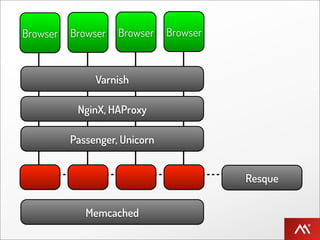





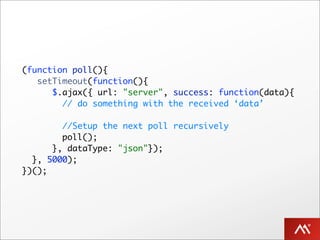




























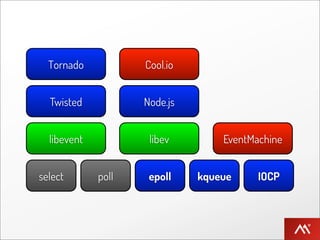

![require 'rubygems'
require 'rack'
class Test
def call(env)
sleep 1 # on purpose, simulating a blocking operation
[200, {"Content-Type" => "text/plain"},
["Hello World!"]]
end
end
Rack::Handler::Thin.run Test.new](https://image.slidesharecdn.com/toster-120211041651-phpapp02/85/Toster-Understanding-the-Rails-Web-Model-and-Scalability-Options-74-320.jpg)
![require 'rubygems'
require 'rack'
class Test
def call(env)
EM.defer do
sleep 1 # CPU bound, throw to thread-pool (cheating)
end
[200, {"Content-Type" => "text/plain"},
["Hello World!"]]
end
end
Rack::Handler::Thin.run Test.new](https://image.slidesharecdn.com/toster-120211041651-phpapp02/85/Toster-Understanding-the-Rails-Web-Model-and-Scalability-Options-75-320.jpg)
![require 'rubygems'
require 'rack'
class Test
def call(env)
EM.defer do
sleep 1 # CPU bound, throw to thread-pool (cheating)
end
[200, {"Content-Type" => "text/plain"},
["Hello World!"]]
end
end
Rack::Handler::Thin.run Test.new](https://image.slidesharecdn.com/toster-120211041651-phpapp02/85/Toster-Understanding-the-Rails-Web-Model-and-Scalability-Options-76-320.jpg)
![require 'rubygems'
require 'rack'
class Test
def call(env)
EM.defer do
sleep 1 # CPU bound, throw to thread-pool (cheating)
end
[200, {"Content-Type" => "text/plain"},
["Hello World!"]]
end
end
Rack::Handler::Thin.run Test.new](https://image.slidesharecdn.com/toster-120211041651-phpapp02/85/Toster-Understanding-the-Rails-Web-Model-and-Scalability-Options-77-320.jpg)
![ab -n 10 -c 1 http://127.0.0.1:8080/
This is ApacheBench, Version 2.3 <$Revision: 1178079 $>
...
Concurrency Level: 1
Time taken for tests: 0.003 seconds
...
Requests per second: 3219.58 [#/sec] (mean)
Time per request: 0.311 [ms] (mean)
Time per request: 0.311 [ms] (mean, across all concurrent requests)
Transfer rate: 380.44 [Kbytes/sec] received
...](https://image.slidesharecdn.com/toster-120211041651-phpapp02/85/Toster-Understanding-the-Rails-Web-Model-and-Scalability-Options-78-320.jpg)
![ab -n 10 -c 1 http://127.0.0.1:8080/
This is ApacheBench, Version 2.3 <$Revision: 1178079 $>
...
Concurrency Level: 1
Time taken for tests: 0.003 seconds
...
Requests per second: 3219.58 [#/sec] (mean)
Time per request: 0.311 [ms] (mean)
Time per request: 0.311 [ms] (mean, across all concurrent requests)
Transfer rate: 380.44 [Kbytes/sec] received
...](https://image.slidesharecdn.com/toster-120211041651-phpapp02/85/Toster-Understanding-the-Rails-Web-Model-and-Scalability-Options-79-320.jpg)
![ab -n 10 -c 1 http://127.0.0.1:8080/
This is ApacheBench, Version 2.3 <$Revision: 1178079 $>
...
Concurrency Level: 1
Time taken for tests: 0.003 seconds
...
Requests per second: 3219.58 [#/sec] (mean)
Time per request: 0.311 [ms] (mean)
Time per request: 0.311 [ms] (mean, across all concurrent requests)
Transfer rate: 380.44 [Kbytes/sec] received
...](https://image.slidesharecdn.com/toster-120211041651-phpapp02/85/Toster-Understanding-the-Rails-Web-Model-and-Scalability-Options-80-320.jpg)
![ab -n 10 -c 1 http://127.0.0.1:8080/
This is ApacheBench, Version 2.3 <$Revision: 1178079 $>
...
Concurrency Level: 1
Time taken for tests: 0.003 seconds
...
Requests per second: 3219.58 [#/sec] (mean)
Time per request: 0.311 [ms] (mean)
Time per request: 0.311 [ms] (mean, across all concurrent requests)
Transfer rate: 380.44 [Kbytes/sec] received
...](https://image.slidesharecdn.com/toster-120211041651-phpapp02/85/Toster-Understanding-the-Rails-Web-Model-and-Scalability-Options-81-320.jpg)
![ab -n 10 -c 1 http://127.0.0.1:8080/
This is ApacheBench, Version 2.3 <$Revision: 1178079 $>
...
Concurrency Level: 1
Time taken for tests: 0.003 seconds
...
Requests per second: 3219.58 [#/sec] (mean)
Time per request: 0.311 [ms] (mean)
Time per request: 0.311 [ms] (mean, across all concurrent requests)
Transfer rate: 380.44 [Kbytes/sec] received
...](https://image.slidesharecdn.com/toster-120211041651-phpapp02/85/Toster-Understanding-the-Rails-Web-Model-and-Scalability-Options-82-320.jpg)
![ab -n 10 -c 1 http://127.0.0.1:8080/
This is ApacheBench, Version 2.3 <$Revision: 1178079 $>
#ZOMG!
...
Concurrency Level: 1
Time taken for tests: 0.003 seconds
...
Requests per second: 3219.58 [#/sec] (mean)
Time per request: 0.311 [ms] (mean)
Time per request: 0.311 [ms] (mean, across all concurrent requests)
Transfer rate: 380.44 [Kbytes/sec] received
...](https://image.slidesharecdn.com/toster-120211041651-phpapp02/85/Toster-Understanding-the-Rails-Web-Model-and-Scalability-Options-83-320.jpg)
![ab -n 10 -c 10 http://127.0.0.1:8080/
This is ApacheBench, Version 2.3 <$Revision: 1178079 $>
...
Concurrency Level: 10
Time taken for tests: 0.002 seconds
...
Requests per second: 5211.05 [#/sec] (mean)
Time per request: 1.919 [ms] (mean)
Time per request: 0.192 [ms] (mean, across all concurrent requests)
Transfer rate: 615.76 [Kbytes/sec] received
...](https://image.slidesharecdn.com/toster-120211041651-phpapp02/85/Toster-Understanding-the-Rails-Web-Model-and-Scalability-Options-84-320.jpg)





![require 'rubygems' # or use Bundler.setup
require 'eventmachine'
class EchoServer < EM::Connection
def receive_data(data)
if data.strip =~ /[exit|quit]$/i
EM.stop
else
send_data("Repeating: #{data}")
end
end
end](https://image.slidesharecdn.com/toster-120211041651-phpapp02/85/Toster-Understanding-the-Rails-Web-Model-and-Scalability-Options-90-320.jpg)
![require 'rubygems' # or use Bundler.setup
require 'eventmachine'
class EchoServer < EM::Connection
def receive_data(data)
if data.strip =~ /[exit|quit]$/i
EM.stop
else
send_data("Repeating: #{data}")
end
end
end
EventMachine.run do
# hit Control + C to stop
Signal.trap("INT") { EM.stop }
Signal.trap("TERM") { EM.stop }
EM.start_server("0.0.0.0", 10000, EchoServer)
end](https://image.slidesharecdn.com/toster-120211041651-phpapp02/85/Toster-Understanding-the-Rails-Web-Model-and-Scalability-Options-91-320.jpg)
![$ telnet localhost 10000
Trying 127.0.0.1...
Connected to localhost.
Escape character is '^]'.
Hello World](https://image.slidesharecdn.com/toster-120211041651-phpapp02/85/Toster-Understanding-the-Rails-Web-Model-and-Scalability-Options-92-320.jpg)
![$ telnet localhost 10000
Trying 127.0.0.1...
Connected to localhost.
Escape character is '^]'.
Hello World
Repeating: Hello World](https://image.slidesharecdn.com/toster-120211041651-phpapp02/85/Toster-Understanding-the-Rails-Web-Model-and-Scalability-Options-93-320.jpg)
![$ telnet localhost 10000
Trying 127.0.0.1...
Connected to localhost.
Escape character is '^]'.
Hello World
Repeating: Hello World
Play again, Sam](https://image.slidesharecdn.com/toster-120211041651-phpapp02/85/Toster-Understanding-the-Rails-Web-Model-and-Scalability-Options-94-320.jpg)
![$ telnet localhost 10000
Trying 127.0.0.1...
Connected to localhost.
Escape character is '^]'.
Hello World
Repeating: Hello World
Play again, Sam
Repeating: Play again, Sam](https://image.slidesharecdn.com/toster-120211041651-phpapp02/85/Toster-Understanding-the-Rails-Web-Model-and-Scalability-Options-95-320.jpg)
![$ telnet localhost 10000
Trying 127.0.0.1...
Connected to localhost.
Escape character is '^]'.
Hello World
Repeating: Hello World
Play again, Sam
Repeating: Play again, Sam
quit
.](https://image.slidesharecdn.com/toster-120211041651-phpapp02/85/Toster-Understanding-the-Rails-Web-Model-and-Scalability-Options-96-320.jpg)
![$ telnet localhost 10000
Trying 127.0.0.1...
Connected to localhost.
Escape character is '^]'.
Hello World
Repeating: Hello World
Play again, Sam
Repeating: Play again, Sam
quit
Connection closed by foreign host.](https://image.slidesharecdn.com/toster-120211041651-phpapp02/85/Toster-Understanding-the-Rails-Web-Model-and-Scalability-Options-97-320.jpg)







![ab -n 1000 -c 5 http://127.0.0.1:9876/
This is ApacheBench, Version 2.3 <$Revision: 1178079 $>
...
Concurrency Level: 5
Time taken for tests: 0.124 seconds
...
Requests per second: 8035.36 [#/sec] (mean)
Time per request: 0.622 [ms] (mean)
Time per request: 0.124 [ms] (mean, across all concurrent requests)
Transfer rate: 588.53 [Kbytes/sec] received
...](https://image.slidesharecdn.com/toster-120211041651-phpapp02/85/Toster-Understanding-the-Rails-Web-Model-and-Scalability-Options-105-320.jpg)
![require 'rubygems'
require 'rack'
Rack::Handler::Thin.run Proc.new {
[200, {"Content-Type" => "text/plain"}, ["Hello World!"]]
}](https://image.slidesharecdn.com/toster-120211041651-phpapp02/85/Toster-Understanding-the-Rails-Web-Model-and-Scalability-Options-106-320.jpg)
![ab -n 1000 -c 5 http://127.0.0.1:8080/
This is ApacheBench, Version 2.3 <$Revision: 1178079 $>
...
Concurrency Level: 5
Time taken for tests: 0.121 seconds
..
Requests per second: 8239.06 [#/sec] (mean)
Time per request: 0.607 [ms] (mean)
Time per request: 0.121 [ms] (mean, across all concurrent requests)
Transfer rate: 973.56 [Kbytes/sec] received
...](https://image.slidesharecdn.com/toster-120211041651-phpapp02/85/Toster-Understanding-the-Rails-Web-Model-and-Scalability-Options-107-320.jpg)



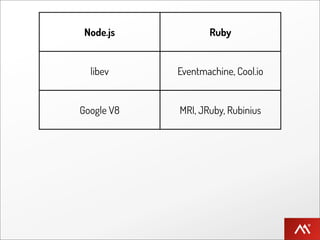
































![require 'goliath'
require 'yajl'
G = Goliath::Rack # don’t to this, just to fit in this slide :-)
class Echo < Goliath::API
use G::Render, 'json' # auto-negotiate response format
use G::Params # parse & merge query and body parameters
use G::Validation::RequiredParam, {:key => 'echo'}
def process_request
logger.info "Processing request"
{response: env.params['echo']}
end
def response(env)
[200, {}, process_request]
end
end](https://image.slidesharecdn.com/toster-120211041651-phpapp02/85/Toster-Understanding-the-Rails-Web-Model-and-Scalability-Options-144-320.jpg)




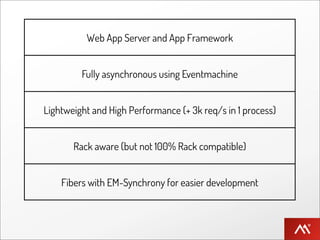








![require 'rubygems'
require 'pusher'
Pusher.app_id = '14909'
Pusher.key = '7114e...c318e'
Pusher.secret = '25aa7...3d49c'
('a'..'z').each do |letter|
doc = { :elem_id => letter,
:value => "Letter: #{letter}"}
Pusher['demo-channel'].trigger('create', doc)
end](https://image.slidesharecdn.com/toster-120211041651-phpapp02/85/Toster-Understanding-the-Rails-Web-Model-and-Scalability-Options-158-320.jpg)

![require 'rubygems'
require 'pusher'
require 'eventmachine'
Pusher.app_id = '14909'
Pusher.key = '7114e...c318e'
Pusher.secret = '25aa7...d49c'
EM.run do
EM::Iterator.new("a".."z").each do |letter, iter|
doc = { :elem_id => elem_id,
:value => "Letter: #{letter}" }
pusher = Pusher['demo-channel'].trigger_async('create', doc)
pusher.callback { EM.stop if letter == 'z' }
pusher.errback { |error| EM.stop if letter == 'z' }
iter.next
end
end](https://image.slidesharecdn.com/toster-120211041651-phpapp02/85/Toster-Understanding-the-Rails-Web-Model-and-Scalability-Options-160-320.jpg)
![require 'rubygems'
require 'pusher'
require 'eventmachine'
Pusher.app_id = '14909'
Pusher.key = '7114e...c318e'
Pusher.secret = '25aa7...d49c'
EM.run do
EM::Iterator.new("a".."z").each do |letter, iter|
doc = { :elem_id => elem_id,
:value => "Letter: #{letter}" }
pusher = Pusher['demo-channel'].trigger_async('create', doc)
pusher.callback { EM.stop if letter == 'z' }
pusher.errback { |error| EM.stop if letter == 'z' }
iter.next
end
end](https://image.slidesharecdn.com/toster-120211041651-phpapp02/85/Toster-Understanding-the-Rails-Web-Model-and-Scalability-Options-161-320.jpg)
![require 'rubygems'
require 'pusher'
require 'eventmachine'
Pusher.app_id = '14909'
Pusher.key = '7114e...c318e'
Pusher.secret = '25aa7...d49c'
EM.run do
EM::Iterator.new("a".."z").each do |letter, iter|
doc = { :elem_id => elem_id,
:value => "Letter: #{letter}" }
pusher = Pusher['demo-channel'].trigger_async('create', doc)
pusher.callback { EM.stop if letter == 'z' }
pusher.errback { |error| EM.stop if letter == 'z' }
iter.next
end
end](https://image.slidesharecdn.com/toster-120211041651-phpapp02/85/Toster-Understanding-the-Rails-Web-Model-and-Scalability-Options-162-320.jpg)




























































































































